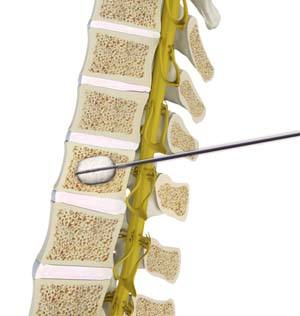Kyphoplasty

Balloon Kyphoplasty
Balloon kyphoplasty is a spine surgery that relieves back pain caused by a vertebral compression fracture. Osteoporosis (bone disease) is the primary cause of vertebral compression fractures. Other causes include trauma such as a fall or motor vehicle accident, and some types of cancers affecting the spinal vertebrae. The aim of balloon kyphoplasty is to relieve pain, stabilize the fracture and restore the vertebral body height.
Your doctor recommends balloon kyphoplasty if you have severe pain and deformity that is not relieved by non-surgical treatment modes including rest, pain medications, and braces.
The surgery is performed under general anaesthesia. During the procedure, you will lie face down on the operating table. A small incision is made in the back through which a narrow tube is inserted into the compressed vertebra under the guidance of live X-ray. Then a special balloon is inserted through this tube and carefully inflated. This elevates the fracture and restores the vertebra to its original height. The balloon is then deflated and removed leaving behind an open cavity. The cavity is filled with bone cement with the help of miniature surgical instruments. The cement hardens within a few minutes and stabilizes the bone.
You may experience significant pain relief following surgery and will be allowed to get up and walk. Your doctor will prescribe pain medication if necessary and recommend a rehabilitation program to strengthen your spinal muscles. You should avoid strenuous activities for at least 6 weeks.
As with any surgery, balloon kyphoplasty may be associated with certain complications which include infection, nerve or spinal cord injury and cement particles entering the blood or spinal fluid.
Spinal Decompression
Spinal decompression is treatment to relieve pressure on one or many “pinched nerves” of the spinal column. It can be achieved either surgically or by non-surgical methods. It is used to treat conditions which cause chronic backache such as herniated disc, disc bulge, sciatica and spinal stenosis.
Non-surgical Method
A safe and non-invasive form of spinal decompression therapy is performed by a professional qualified to use a decompression machine. By this method, more room is created within the spinal column thus relieving the spinal cord and nerves from pressure. It takes nearly 15-24 treatment sessions to achieve the best results.
The DRX 9000 Spinal decompression machine is widely used to relieve chronic lower back pain. It works by creating space between the vertebrae and damaged spinal discs, helping them to heal.
The Process
When undergoing spinal decompression, you will be made to rest on a therapeutic table that is connected to a computer which sends electronic information to stretch and decompress the spinal structure. A padded harness is worn and during the spinal decompression session, gentle force is applied to the spinal column, focusing on the area for treatment. Pressure is applied decompressing the spine, the intervertebral discs and the joints. You will experience multiple cycles of treatment lasting 2-3 minutes in each spinal decompression session. The machine is monitored by a technician. Even though you may get relief in a single therapy session, you should complete the full treatment cycle plan to gain complete healing of the injured disc.
Surgical Method:
Surgical spinal decompression is performed by two procedures:
- Microdiscectomy/micro decompression
- Laminectomy/open decompression
Microdiscectomy: This is a minimally invasive procedure which involves removal of a portion of a herniated nucleus pulposus by a surgical instrument or LASER.
Laminectomy: This is a procedure in which a small portion of the arch of the vertebrae is removed to relieve pressure on the pinched nerve. This is performed as a last resort, when conservative treatment fails to provide relief from back pain.
